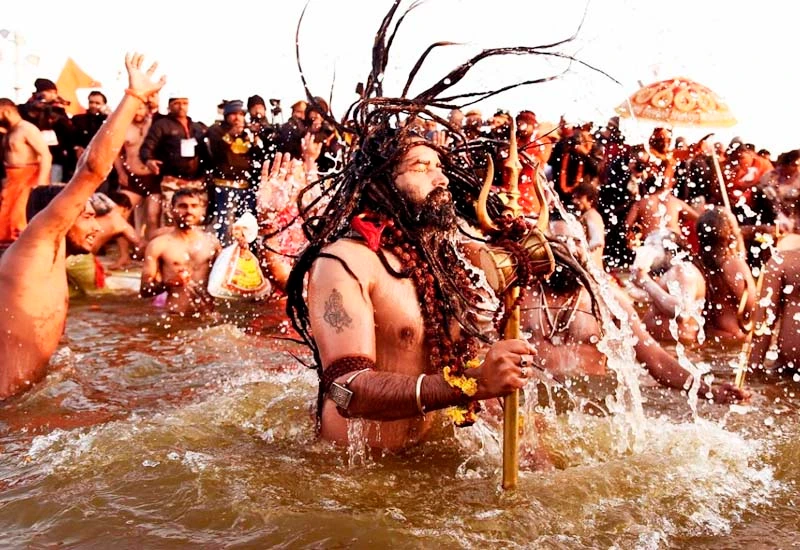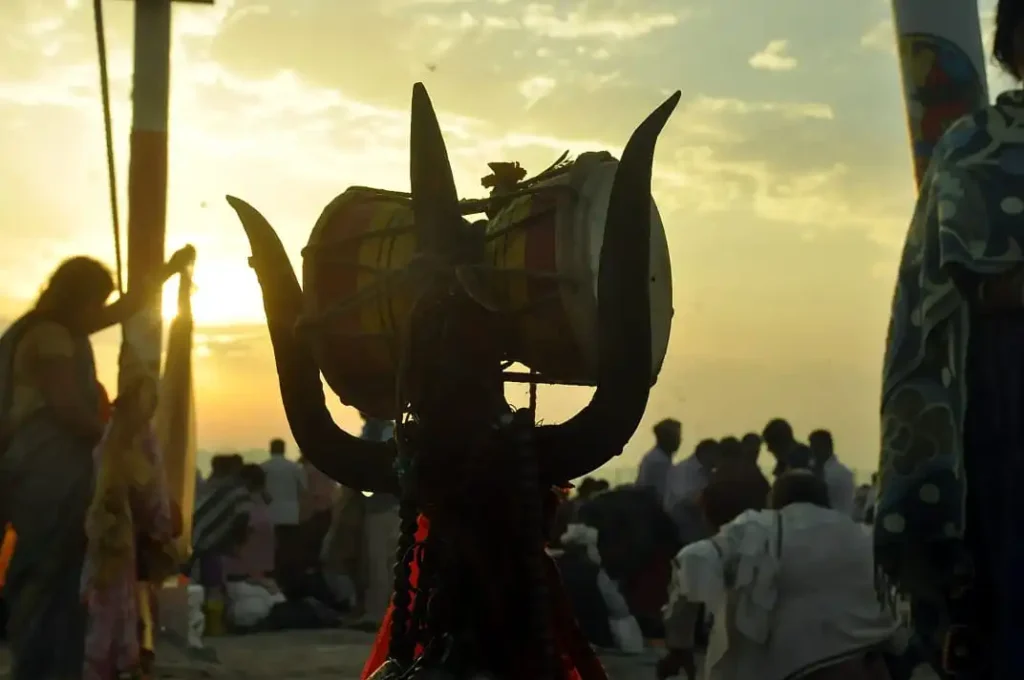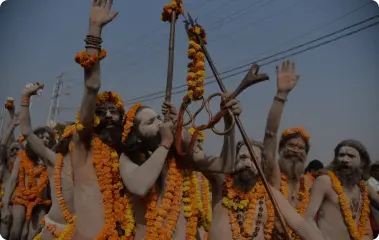The Sacred Order of Akhadas: Ancient Spiritual Warriors at Kumbh Mela
Introduction to Akhadas
The Akhadas represent India’s ancient monastic traditions, serving as spiritual powerhouses at the Kumbh Mela in Prayagraj. These sacred orders, with histories spanning centuries, form the backbone of the world’s largest spiritual gathering. Each Akhada maintains distinct practices, philosophies, and traditions while collectively preserving Sanatan Dharma’s timeless wisdom.
Major Classifications of Akhadas
Shaiva Akhadas: Followers of Lord Shiva
Juna Akhada
- Oldest and largest monastic order
- Famous for Naga Sadhus with ash-covered bodies
- Maintains strict discipline in spiritual practices
- Known for elaborate rituals during Shahi Snan
Niranjani Akhada
- Renowned for scholarly traditions
- Emphasizes systematic spiritual education
- Preserves ancient texts and commentaries
- Conducts regular spiritual discourses
Agni Akhada
- Specializes in Vedic studies
- Maintains ancient fire rituals
- Focuses on Sanskrit education
- Preserves traditional manuscript collections
Vaishnava Akhadas: Devotees of Lord Vishnu
Nirmohi Akhada
- Emphasizes complete renunciation
- Practices bhakti-centered spirituality
- Maintains strict dietary regulations
- Known for melodious bhajan traditions
Digambar Akhada
- Practices extreme austerity
- Focuses on meditation techniques
- Maintains simple living principles
- Emphasizes environmental consciousness
Udasin Akhadas: The Neutral Order
Bada Udasin Akhada
- Promotes universal spirituality
- Combines various philosophical traditions
- Emphasizes meditation and yoga
- Maintains extensive charitable activities
Shakti Akhadas: Embodiment of Divine Power
Mahanirvani Akhada
- Blends Shaiva and Shakta traditions
- Practices advanced tantric rituals
- Maintains mystic traditions
- Known for powerful spiritual practices
Special Focus: Modern Inclusivity
Kinnar Akhada
- Represents transgender spiritual practitioners
- Promotes equality in spiritual pursuit
- Combines traditional practices with modern inclusivity
- Demonstrates evolving nature of spiritual traditions
Spiritual Practices and Daily Life
Common Practices Across Akhadas
- Dawn meditation sessions
- Regular fire ceremonies
- Scriptural studies
- Community service
- Yogic practices
- Environmental conservation
Role During Kumbh Mela
- Leading Shahi Snan processions
- Conducting mass spiritual discourses
- Organizing traditional ceremonies
- Providing spiritual guidance to pilgrims
- Maintaining sacred traditions
Cultural Significance
Preservation of Traditions
- Ancient meditation techniques
- Vedic chanting methods
- Traditional healing practices
- Sacred art forms
- Spiritual music traditions
Educational Role
- Sanskrit education
- Vedic mathematics
- Traditional medicine
- Spiritual counseling
- Environmental awareness
Visiting Guidelines
Etiquette for Visitors
- Appropriate dress code
- Respectful behavior
- Photography restrictions
- Offering protocols
- Interaction guidelines
Best Times to Visit
- During morning ceremonies
- Evening prayer sessions
- Special festival days
- Public discourse times
- Cultural performance hours
Historical Evolution
Ancient Origins
- Warrior-monk traditions
- Protection of sacred sites
- Preservation of knowledge
- Spiritual lineages
- Traditional governance
Modern Adaptations
- Contemporary relevance
- Social service initiatives
- Environmental programs
- Educational activities
- Cultural preservation
Contribution to Kumbh Mela
Ceremonial Roles
- Leading sacred processions
- Conducting mass rituals
- Organizing spiritual gatherings
- Maintaining festival discipline
- Preserving traditional practices
.
Akhada Tour
Akhada Visits at Kumbh Mela: A Spiritual Journey at Prayagraj
The Shaiva Akhadas, like Juna Akhada, Avahan Akhada, and Agni Akhada, are dedicated to Lord Shiva. These Akhadas are famous for their strict discipline, meditation practices, and teachings on ancient scriptures. Juna Akhada is the oldest and largest, known for its Naga Sadhus who follow a strict ascetic lifestyle.
The Vaishnava Akhadas, including Nirmohi Akhada and Digambar Akhada, are dedicated to Lord Vishnu. These Akhadas focus on spiritual awakening, devotion, and austerity. They offer deep teachings on renunciation and dedication to Lord Vishnu.
The Udasin Akhadas, such as Bada Udasin Akhada and Naya Udasin Akhada, focus on asceticism and spreading spiritual teachings. The Shakti Akhadas, including Mahanirvani Akhada, combine Shaiva and Shakta traditions, rooted in mysticism. Kinnar Akhada, a recent addition to the Kumbh Mela, represents the transgender community and promotes inclusivity and equality in spiritual practices.
The Sri Panchayati Akhada brings together worship of various deities and promotes community welfare and spiritual harmony. During the Shahi Snan processions at the Triveni Sangam, saints, and ascetics from these Akhadas lead the way, and pilgrims follow to take a holy dip, believed to purify the soul.
The Kinnar Akhada symbolizes the inclusivity of the Kumbh Mela, showing that the festival embraces all spiritual communities. Visitors to the Kumbh Mela can witness the vibrant rituals of these Akhadas, experience their teachings, and immerse themselves in the spiritual atmosphere of the festival.
The Akhada visits are a vital part of the Prayagraj Heritage Walk and are an unforgettable experience for anyone attending the Maha Kumbh Mela 2025. If you’re looking for a deep spiritual journey, a visit to the Akhadas is a must. Explore the sacred practices, rituals, and teachings of these holy orders while connecting with the spiritual heart of the Kumbh Mela at Prayagraj
The Akhadas play a central role in the Kumbh Mela, especially during the Shahi Snan. In this ceremonial procession, saints and ascetics lead devotees for a Holy Dip in the Triveni Sangam. These processions are marked by vibrant rituals, showcasing the spiritual and cultural
grandeur of the Kumbh Mela festival. The inclusion of the Kinnar Akhada in recent years symbolizes the evolving inclusivity of the
festival, honoring the spiritual significance of all communities. Visitors can witness the profound
rituals of the Akhadas during the Maha Kumbh Mela 2025, making it an unforgettable spiritual journey
Akhada Visit
- Pickup from Current Location: Our guide will pick you up from your hotel, guest house, or airport near Prayagraj.
- Comfortable ride to Prayagraj's top attractions begins.
- Brief introduction to Prayag, Kumbh Mela, and your tour highlights
The oldest and largest Akhada, known for its strict discipline and Naga
Sadhus
Famous for its deep meditation practices and rituals.
Focuses on Vedic studies and preserving ancient texts.
Highly respected for its scholars and spiritual teachings
Combines spiritual practices with a focus on self-discipline
Known for its inclusive philosophy and devotion to Lord Shiva
Focuses on renunciation and devotion to Lord Vishnu.
Promotes spiritual awakening through austerity.
Revered for its dedication to serving humanity.
Emphasizes asceticism and simplicity.
: Known for spreading spiritual teachings across communities.
A blend of Shaiva and Shakta traditions, deeply rooted in
mysticism
Represents the transgender community, promoting inclusivity and
equality in spiritual practices.
Focuses on the collective worship of various deities and
community welfare.
The Trip Cost Includes
- Pick-up or Drop-off service from and to Airport(in our own vehicle)
- Transportation to and from!!
- Food all along the trip(Breakfast, Lunch, Dinner and a cup of coffee or tea) and accommodations during the trip in hotels with family environment
- Transportation, food, accommodation and insurance of Guide during the trip
- Down jacket, all-season sleeping bag, duffel bag and trekking map(in case if you don’t have your own. Down jacket, sleeping bag and duffel bag must be returned after completion of the trip)
- First Aid Medical Kit(Your guide will carry the Medical Kit but we also advise to bring yourself for your own use, as far as possible)
- All the required permits and paperwork
The Trip Cost Excludes
- International Airfare
- Visa Charges
- Hotel Expenses(In Kathmandu, some packages do include hotel expenses)
- Your travel and medical insurance
- Personal Expenses such as shopping, bar bills, hot shower, telephone, laundry, titbits etc
- Food and accommodations in Kathmandu
- Services not mentioned or not promised by the agent/agency
- Emergency expenses such as expenses on chartered helicopter.
Annapurna Base Camp is a Grade B or a moderately difficult trekking route. So any fit person can do this trek, even if you do not have any previous experience. You should be aware of what to expect and mentally prepare for it. Then, as long as you will to, you can.
On average, you walk about 4 to 6 hours per day. One or two days can be as less as 3hrs and one or two days can be as long as 7hrs.
The highest altitude reached is 4190m. This is the elevation of Annapurna Base Camp. ABC is the highest we will climb in this trek.
Yes, you can charge batteries en route. Charger should be brought. There are hot shower facilities as well. You may have to pay certain amount for both ($1-$2). Negotiate. Also, hot water facility could be free at lower elevation.
No. There are no ATMs on this trek route. You will have to draw enough cash in Pokhara or Kathmandu. There are a number of ATMs in these cities. Everything is paid in Nepali rupees. So money should be exchanged before the start of the trek.
Yes. Internet can be accessed in most places. Sometimes, there might be some technical problems. Internet in Nepal is not as fast as you are used to and at times you can just lose connection.
Not really. It depends on you. If you want, ABC trekking can be done independently. You could hire a guide and a porter by yourself instead of going through an agency or not hire a guide at all. Although, not having a guide can be a little problematic during off season.
It really depends on you. Is it your first time in Nepal? How confident are you of being able to find your way around? How pressed on time are you? If you go through an agency, it will be costlier but everything will be planned. You will only have to come, trek and return.
For Annapurna region, pay for guides range from $20 to $30 per day and porters take $15 to $25 per day.






